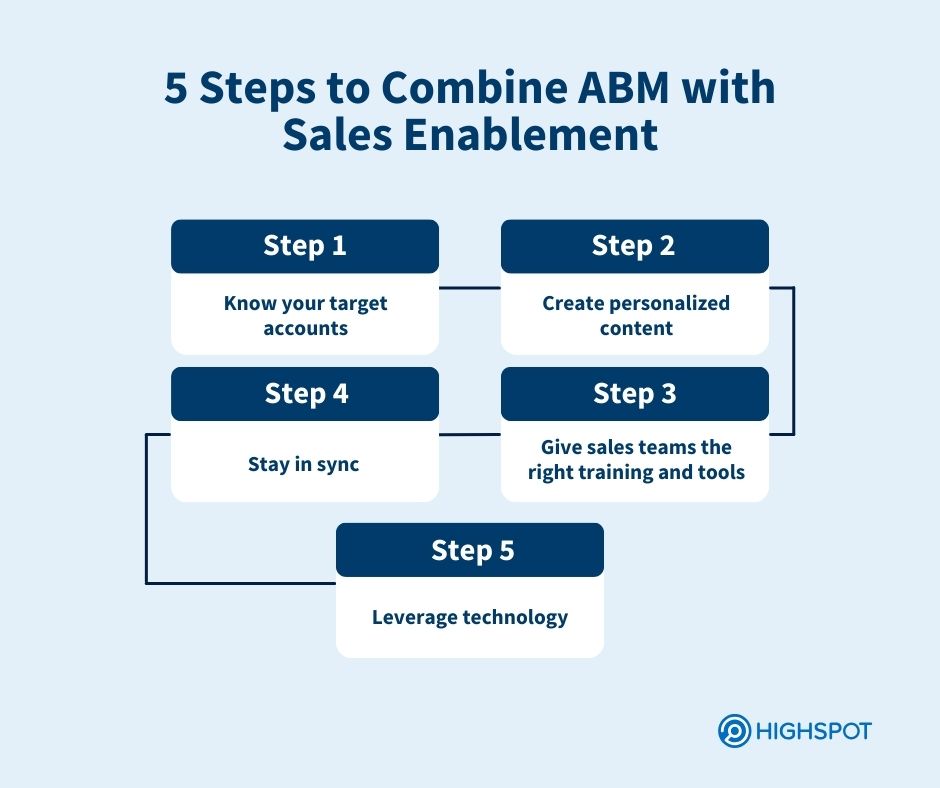Key takeaways
- ABM and sales enablement help teams focus on the right accounts and equip reps with the tools to convert prospects into customers.
- Tools like AI sales coaching, just-in-time learning, and dynamic playbooks help reps respond to buyer needs at every journey stage.
- Companies that align their sales and marketing grow 19% faster and 15% more profitably.
When digital marketing emerged in the early 2000s, automation made reaching massive numbers of leads easy, but it often overwhelmed sales and marketing teams with unqualified prospects. Now the focus is shifting back to account-based selling strategies.
Organizations have realized that certain key accounts drive the highest lifetime value (LTV) with lower customer acquisition costs (CAC).
Account-based marketing (ABM) with sales enablement solves common pain points in sales and marketing efforts. Using an ABM approach frees sales reps from low-quality leads, while sales enablement tools equip them with personalized content. This increases win rates, shortens sales cycles, and increases revenue from key accounts.
According to Forrester, companies that align sales and marketing grow 19% faster and are 15% more profitable.
In this article, you’ll learn how ABM strategy and sales enablement work together, practical steps to align marketing and sales, and a comparison chart showing how the two work together across content, data, and outcomes.
What is account-based marketing?
Account-based marketing (ABM) is a strategic approach that targets high-value accounts rather than casting a wide net. It emphasizes quality over quantity. The focus is on very targeted and personalized messaging to engage prospects and improve conversion rates.
Many companies have realized that most long-term customers belong to a specific vertical, revenue tier, or buying behavior profile. ABM flips the script on mass marketing by focusing on accounts with the most revenue potential.
For example, a company might target 10 large healthcare clients with tailored ABM programs rather than 1,000 small leads across industry sectors. This precision builds efficiency and trust through account-specific sales messaging.
What is sales enablement?
Sales enablement gives sales organizations the tools, content, and training to engage buyers effectively. It ensures reps have timely resources to navigate the B2B buyer’s journey. By aligning materials to the sales process, sales enablement adds value by turning sales reps into trusted advisors.
How do ABM and sales enablement align?
Sales enablement and account-based marketing work together to keep buyers engaged. ABM leads the way at the middle of the funnel, creating personalized content that nurtures the right accounts and builds momentum.
Then, as prospects reach the bottom of the funnel, sales enablement steps in, helping reps tailor their messaging, choose the right moment to connect, and use data to close deals faster.
| ABM | Sales Enablement | |
|---|---|---|
| Primary Focus | Identify and attract high-value accounts | Prepares sales reps to engage and convert accounts |
| Content Role | Create personalized campaigns and content | Ensure content is available for sales |
| Data Usage | Data and intelligence are required to deliver full-funnel insights on target accounts | Track prospect interactions, content usage, and suggest next steps using enablement intelligence |
| Outcome | High-value account identification | Improved buyer engagement and conversion rates |
5 steps to combine ABM with sales enablement
While aligning ABM with sales enablement may seem straightforward, many teams struggle without a clear plan. The key is to link the intended outcome with the path to achieve it, starting with shared account data and open communication.
Below are five practical steps your marketing and sales teams can take together to get started.

1. Know your target accounts
Collaboration is key because sales and marketing teams must work together to define Ideal Customer Profiles (ICPs) using CRM data and market research. This will generate the most highly qualified leads.
Concentrate on company size, industry, and buying behavior to narrow your focus and pinpoint high-value accounts. You can also look at intent data to identify accounts actively researching solutions like yours.
For example, track website visits or content downloads to learn which companies are in the buying process, so sales reps can focus on prospects ready to engage.
Without this focus, 56% of opportunities handed off to sales fail to close successfully, wasting time on unqualified leads and clogging the sales funnel.
Below is a quick checklist for identifying target accounts:
- Company size and revenue: Target companies within a specific revenue range or employee count, such as $ 10 M- $ 50 M annual revenue.
- Industry and vertical: Focus on industries where your solutions have proven results, like technology, healthcare, or financial services.
- Buying behavior: Prioritize companies that adopt new tech early or those actively looking for solutions like yours.
- Key decision-makers: Identify roles with purchasing authority or influence, such as Chief Revenue Officers, Heads of Sales, or Marketing Directors.
- Intent signals: Use tools to identify accounts showing interest (e.g., website engagement, resource downloads, or searching for relevant keywords).
2. Create personalized content that supports the buyer’s journey
Generic content won’t work for ABM. In fact, about 65% of content marketing assets go unused because they’re irrelevant, highlighting the need for personalization. Marketing teams should create buyer stage-specific content with sales to address prospect pain points.
ABM content should speak to the entire buying committee, from decision-makers to influencers.
For example, a software vendor targeting a healthcare account might create a whitepaper for the CIO and a case study for the operations lead so sales reps can engage all key stakeholders with coordinated messaging and relevant resources.
Valuable ABM + sales enablement content types include:
- Industry-specific case studies: Showcase successes within their industry.
- Personalized sales decks: Presentations addressing their unique needs.
- Whitepapers and reports: In-depth insights to solve their most significant pain points.
- Custom video demos: Visual solutions to their challenges.
- Stakeholder-specific briefs: Concise materials for different roles within the account (e.g., technical specs for IT, ROI analyses for finance).
3. Give sales teams the right training and tools
ABM marketing works best when sales reps have the right support at the right time. That’s where sales enablement comes in by providing the tools and resources they need to engage with high-value accounts confidently.
This can include interactive product demos, deal-specific sales playbooks, and real-time buyer insights.
Sales playbook components include:
- Objection-handling tips: Quick responses to common pushbacks, like budget or timing concerns, to keep conversations moving.
- ICP-specific messaging: Tailored narratives that make sense to buyer personas, such as CIOs in healthcare or CFOs in finance.
- Real-world case studies: Customer success stories with stats and real-world use cases to build credibility.
- Call scripts: Pre-built outreach tools that help start conversations and stay on message.
- Discovery questions: Questions to uncover pain points and priorities.
- Competitive intelligence: Talking points and comparisons to win head-to-head deals.
Besides that, just-in-time training and AI sales coaching help reps prepare for crucial moments in the sales process, whether a first call, demo, or negotiation.
By including bite-sized, role-relevant learning modules in the playbook, reps can improve their knowledge and skills needed to navigate the challenges of a deal cycle.
4. Stay in sync
Sales and marketing alignment requires ongoing communication and shared accountability. Schedule weekly sync meetings to review progress, refine strategies, and align KPIs using performance data.
Marketing shares campaign updates, and sales provide frontline feedback. This ongoing exchange helps refine campaigns as engagement data rolls in.
For example, if content analytics show a target account interacts more with video demos than whitepapers, marketing can prioritize similar content so sales reps have the best tools to engage in deal-specific conversations and close deals faster.
This feedback and data loop keeps everyone moving in the right direction and prevents silos.
5. Leverage technology
Technology automates manual tasks such as content personalization and buyer interaction tracking.
For example, marketing automation tools send tailored emails to target accounts, CRM integrations track all interactions, and sales enablement platforms with AI and machine learning monitor what content resonates and suggest next steps, increasing pipeline velocity.
This reduces administrative work and maximizes time for buyer engagement.
Turn strategy into impact with unified sales and marketing
When ABM and sales enablement come together, sales reps perform better, and buyers experience the best of your brand. But turning that vision into higher win rates, shorter sales cycles, and revenue growth takes strategy and execution.
It all comes down to close account collaboration, personalized content, and smart data.
Highspot, which offers advanced yet intuitive AI for sales, brings it all together by delivering the right resources at the perfect moment to power your account-based marketing.




